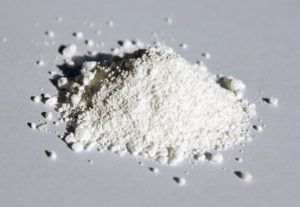Titanium dioxide, also known as titanium(IV) oxide or titania, is the naturally occurring oxide of titanium, chemical formula TiO2.
Contents
Uses
- The most important application areas are paints and varnishes as well as paper and plastics, which account for about 80% of the world’s titanium dioxide consumption. Other pigment applications such as printing inks, fibers, rubber, cosmetic products and foodstuffs account for another 8%. The rest is used in other applications, for instance the production of technical pure titanium, glass and glass ceramics, electrical ceramics, catalysts, electric conductors and chemical intermediates.[26] It also is in most red-coloured candy.
Benefits
- Titanium Dioxide is a naturally occurring mineral used as a coloring agent, whitener, thickening agent, and sunscreen ingredient in cosmetics and personal care products. Its high refractive index makes it a popular ingredient in whitening formulas because it provides a bright reflection; it is also considered an effective opacifier. It is often found in mineral make up formulas, as well as whitening and under eye creams.
- Titanium Dioxide has high UV light absorbing capabilities, and it is often used as an active ingredient in sunscreens; it is found to be resistant to discoloration under UV light. According to Wikipedia, “Sunscreens designed for infants or people with sensitive skin are often based on titanium dioxide and/or zinc oxide, as these mineral UV blockers are believed to cause less likely skin irritation than chemical UV absorber ingredients. The titanium dioxide particles used in sunscreens have to be coated with silica or alumina, because titanium dioxide creates radicals in the photo catalytic reaction. These radicals are carcinogenic, and could damage the skin.”
Cautions
- Much of the clinical concern over Titanium Dioxide is related to occupational hazards. Manufacturing workers are exposed to large quantities of TiO2, including airborne particles and uncoated materials. These conditions have been linked to cancer and Alzheimer’s disease.
- However, the risk of TiO2 on the skin is expected to be less dangerous to users. Titanium Dioxide particles are often coated with silica to minimize negative side effects.
Interactions
Unknown, please consult with your doctor.
Other names
Titania
References
Source: Truthinaging, https://www.truthinaging.com/ingredients/titanium-dioxide
Wikipedia, https://en.wikipedia.org/wiki/Titanium_dioxide
LabDoor, https://labdoor.com/article/titanium-dioxide-is-it-safe-what-are-its-benefits


Make a statement with these bold colors! The colors in the Demure Bold Drama Eye Color Set make your eyes pop with dramatic colors. Visit the website at http://deluviausa.com/shop/demure-mineral-makeup/mineral-eye-color-makeup-kits/demure-bold-drama-eye-color-set-2/
Click to View what Alicia W., Co-Founder of Delúvia Inc. has to say about how the company started and how its products could help others.
https://www.youtube.com/watch?v=ePrifdk1Wus
Made with 100% pure crushed minerals from the earth No chemicals, harmful preservatives or other skin irritants Light weight yet offers great coverage, as well as being water resistant. Not tested on animals and no micronized or nano particles. Zinc is soothing and provides natural sun-protecting benefits
See and feel the difference of natural beauty. Visit the website at http://deluviausa.com/product-category/demure-mineral-makeup/mineral-foundation/
Click to View what Alicia W., Co-Founder of Delúvia Inc. has to say about how the company started and how its products could help others.
https://www.youtube.com/watch?v=ePrifdk1Wus